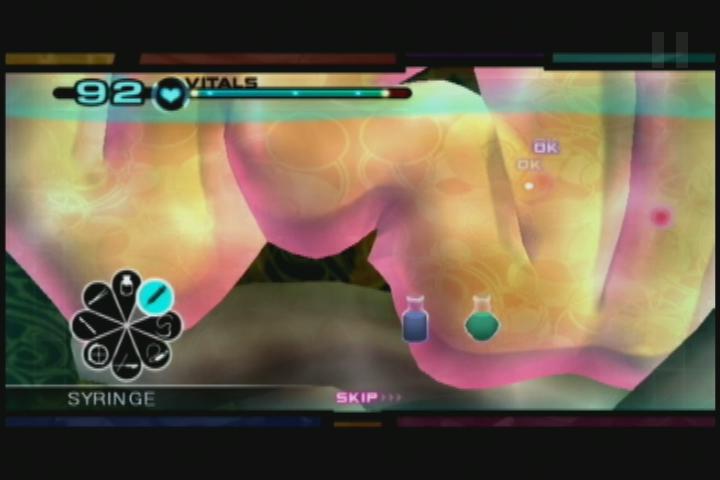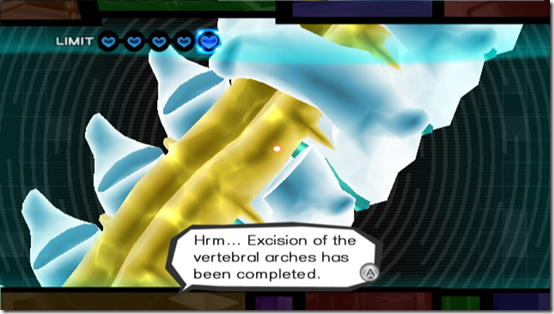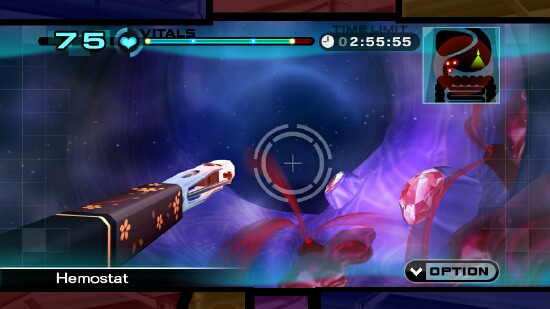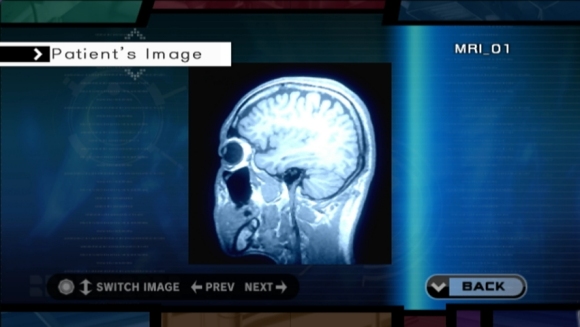If you’ve ever wanted to be a doctor, but would rather not worry about precision, and you long to take a more "House M.D." approach to investigating and treating illnesses, then you’re in luck. Atlus brings back the series that Trauma Center started with Trauma Team, offering 6 different doctors with their own independent specialties, some hearkening back to the series’ surgery roots and others moving more towards the Pheonix Wright point-and-click adventure formula. While it’s clear that Atlus has improved on the treatment aspects of hospital life, the addition of diagnostics and forensics slow down the excitement to an unfortunately semi-realistic pace.
Trauma Team‘s story unfolds in anime-style comic book cutscenes, highlighting each unique and cleverly crafted character’s backstory as well as their interactions with one another. Each doctor/specialty gets between five and seven playable stages (and one final stage unlocked after every other mission is completed), some of which intersect, and some which exist as standalone experiences. I’d highly recommend not trying to go down one specialty track at a time, as this can get somewhat monotonous, but instead mix things up to help keep the varying types of gameplay fresh. It’s also worth noting that all of the characters, while interesting, do feel like stock anime pieces, as do most of the dialogue and story scenes (which are surprisingly heavy on moments of overt sexual tension). The plot is engaging and over the course of the game, the characters grew on me such that I was really cheering for them by the end. It’s probably easiest to talk about each separately, however, given that the specialties never mix during gameplay segments.

I’ll start with Maria Torres, the fiery and busty First Responder who gets caught up in visions of what appears to be a ghost. Her specialty is easily the most exciting and frantic given the Diner Dash-style method in which players treat patients on location. There’s a fair amount of back and forth between taping, suturing, and applying gallons of antibiotic gel, but ultimately this became my favorite specialty because of its intense and evolving nature. Having said that, even on the regular difficulty (Resident) all of the tasks are very manageable, a title-wide change that comes with this iteration of the Trauma series. And in case you are looking to really escape any kind of challenge, the Intern difficulty allows for an easy-breezy playthrough almost akin to constant tutorial. On either difficulty, First Response is exciting, fresh, and mechanically pretty tight.

CR-SO1, easily the best name out of the crew, hails from the local penitentiary where he is also known as the Masked Prisoner because of a large metal bucket covering his head. When it comes time for intricate surgery, however, he ditches the mask and is rushed over to the hospital to put those steady hands to work. Surgery, like in past games, involves removing foreign objects, some ultrasound usage, lots of suction for hemorrhaging, and the occasional timed button press to operate the AED. This is what the series is known for, and this is absolutely where Atlus gets it right again. The controls feel responsive and the tasks, though many, are fun and engaging. Don’t expect serious realism here, given my sometimes laughably mangled suture jobs that garnered a *Good!* rating, and the ever handy "green medicine juice" — basically a fail-safe that continually keeps your patient alive in any situation. But these elements, however unrealistic, are needed in order to produce a workable, less frustrating surgical experience which this specialty definitely achieves.

Hank Freebird performs orthopedic procedures at the hospital, and moonlights as a costumed crime fighter in his off time to repel the horrifying memories of war. There’s not much about orthopedics that seems very different from surgery, except a considerably difficult procedure for creating synthetic bone pieces. Again, this specialty proves that the Trauma series is at its best treating organs and bones in fast-paced, precise operations.

Tomoe Tachibana, the resident Japanese heiress and Endoscopy expert, occupies the quiet, skilled doctor role, which plays in great contrast to some of the more bombastic characters like Torres. Endoscopy shows off a different side of medical practice, and a whole new type of gameplay, where players take controls of a small camera that searches around inside the patient for legions, diseases, etc., and spot-treats them with a few handy tools. The tools function well, though the movement is choppy and difficult using horizontal Wiimote motions along with the Nunchuk’s joystick to navigate. The 3D space the procedures occupy is fairly underwhelming graphically, but fills the necessary role well enough. While this isn’t the game’s strongest segment, it provides nice variety.

I’ll lump the last two, Gabriel Cunningham of Diagnostics and Naomi Kimishima of Forensics, together because they both rely on point-and-click detective mechanics and accomplish function fairly similarly. Whereas Cunningham analyzes patients by sifting through X-Rays, dialogue pieces, and numerous blood work-up charts to obtain clues that he can piece together to form a diagnosis, Kimishima analyzes crime scenes and dead bodies by sifting through personal effects, recorded dialogue pieces, and fingerprint files to obtain clues that she can piece together to form a conclusion regarding the crime. While fans of games like Phoenix Wright may find these specialties a welcome addition to the Trauma Team family, it’s likely that many gamers, like me, will find these segments to be tedious and often frustrating when looking for some elusive, non-intuitive clue that bars progress until located. Maybe medicine just isn’t the field for this kind of gameplay.
The sum of these specialty parts creates Trauma Team, an enjoyable addition to the series. It takes the already enjoyable operation from previous titles, along with some slightly expanded co-op options, and improves upon them with variable difficulties and tighter controls, also providing a relatable, if somewhat hackneyed, storyline stemming from six amusing characters. Diagnostics and forensics may slow down the otherwise exciting pacing of the medical drama, but are not so detrimental as to keep this game from being the best entry in the series so far.


















